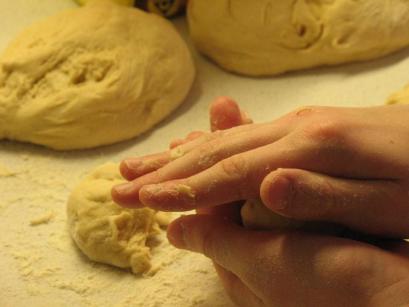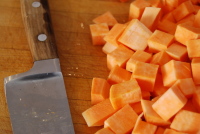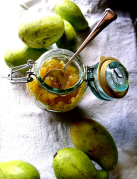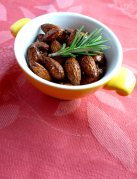I'm going to introduce the subject of the second interview differently. Rachelle's words are so wonderful, I'm going to step aside right away and let you get to them. I'll say a bit more about Rachelle after the interview.
And now, meet Rachelle -- writer, mom, soul-care sage, Magpie Girl and creator of the Small is Beautiful blogging phenomenon:
1. Can you tell us a bit about the exciting transition (some might call it an adventure) you are living and how it’s changing your and your family's food purchasing, preparation and eating practices.
I just moved from Seattle, Washington to Copenhagen, Denmark. My husband Paul got a job here, and we moved over with two girls and a dog in tow.
Seattle was a pretty crunchy-granola place to live. We had Whole Foods and PCC grocery stores, not to mention a seasonal farmer’s market in every neighborhood, and a budding sustainable eating movement.
Still, things are much more wholistic here. There’s less shipping of food from one end of the globe to the other, so you reduce your carbon load by eating locally. You also have to learn how to ‘eat around the seasons’ slow-food style, because produce selections are based more on what’s locally available. (I guess I’ll have to learn to love kale...) The other thing that’s very different is there’s virtually no take-out or fast-food culture here, so it’s not as hard to stick with healthy eating patterns.
People eat very simple meals – Danish breakfasts and lunches are tapas style with whole grain breads (usually still warm), meats, cheeses, and raw veggies. These are made into open face sandwiches called smørrebrød. (open bread) Dinner is usually home cooked with very few canned or frozen foods. There’s not a culture of overtime here, and people put a big emphasis on quitting work on time to go home and enjoy a dish of pasta or a simple soup with your family. Household chores are shared more equally, so men and women are both a part of food prep, and kids are expected to help more and at a younger age. This simplicity and cooperation makes supper time very do-able and pleasant.
One other thing that is dramatically affecting our food shopping habits is that we are car-free and carry our groceries from a small store almost every day. There’s no more driving to the big box store and shopping for two weeks at a time. I can’t buy more than I can easily carry. So many people shop this way that stores don’t even bother offering milk in a gallon jug. Also, shops are closed on Sundays, so you have to plan a bit for the weekend. Once you get used to the rhythm of it, it’s really quite nice.

Eden (Rachelle's daughter) making yeast rolls in CPH (Denmark)
2. Are there are familiar comfort foods you crave that you cannot purchase in Denmark?
My girls love Adams No-Stir Peanut butter. You can buy small jars of peanut butter in Denmark now, but only the kind packed with hydrogenated oil and sugars. The girl’s jar-a-week Adam’s habit is going to have to be reduced in order to make the 4 jars I brought in my suitcase last longer! My husband is distraught over the lack of chocolate chips—I can’t find them anywhere! Oh, and we are rationing our cocktail intake. Liquor is very expensive here, so our cocktail parties with Ten Cane rum-and-cokes and Grey Goose vodka tonics are a thing of the past. For the first time I’m realizing the benefits of the duty free shop at the airport!
3 . I've been reading your blog, Magpie Girl, for about a year now and I love the stories you tell. Can share some stories about the role of food or special recipes or mealtime rituals in your seasonal celebrations and spiritual practices.
The table is a central part of our family’s spirituality. For the past several years we’ve hosted a spiritual growth group that involved eating dinner together with about 12 other people every week. We always started our meal with a ritual around a loaf of bread and a goblet of wine. For the Christians in our group it was akin to a Communion ceremony. But the language was very broad so people of virtually any background could join in. Having that consistent 3 minute ritual anchored us in time and created a sense of gratitude and abundance in our group.
There are also certain holidays that we celebrate every year around our table. The very first weekend that we moved into our house we hosted a chili party to celebrate the Fall Equinox. Everyone hoisted their microbrews and made toasts to the things they loved about the Fall. We also celebrated an interfaith Passover meal each Spring, followed by an Easter brunch. We opened the Summer at Solstice with dinner outdoors under the lilac tree, and closed it each year with a celebration of harvest and provision, dining on fall foods under a makeshift shelter for Sukkoth. (Ed note: Here are links to some stories on Rachelle's old blog: Sukkot, Fall Equinox/Chili Fest, Passover, A typical meal)
4. You're invited to a potluck dinner to get to know your new neighbors. What do you take and why?
I would probably take a hearty homemade soup, and fresh bread. I make terrific challah and my Irish soda bread is so yum! I think soup communicates warmth and simplicity. Passing around warm bowls creates a relaxed atmosphere, and puts everyone at easy with its simplicity. It’s sort of my signature thing to do…although we have been known to show up with dates stuffed with herbed goat cheese and wrapped in prosciutto, and a big pitcher of pomegranate champagne cocktails!
5. What is your desert island cookbook without which you cannot survive? (assume you have a well-equipped kitchen on this desert island and a crate of food washes up on shore.)
I have a bunch of cookbooks, but I don’t really use them. Real Simple had an article a couple of years ago about how to organize your recipes. Now I have four filled with my favorites: Soups/Salads, Baked Goodies, Main Dishes, and Fancy Foods (holiday things and appetizers.) I rip pages from magazines, print things out from epicurious.com, and save index cards from my mother in law. Then every few months, I slip them into sheet protectors and file them in my binders. A lot of my favorites are from Martha Stewart’s Everyday Cooking magazine. Easy and yummy - I love it!
6. What are some tips for making weekday family dinners a time of connection?
I think it’s nice to have a ritual that anchors your family dinner time. Most of the families I admire do this. The Gustafsons hold hands for a moment of silence, the Coolman-Currans have a short prayer they say every night (For this, and us, God bless, Amen.), my sister’s children take turns singing a favorite song. At our house our youngest, Cate, reads a short prayer from 100 Graces: Mealtime Blessings, Marcia & Jack Kelly, ed.—which she asked for as a Christmas present—and then during dinner we share our high point-low point for the day. It doesn’t have to be pious or complicated. Something simple can be very nurturing.
7. I know you excel at making homemade soups and breads. Can you share a favorite recipe for each and perhaps some non-food "ingredients" that go into their preparation.
It’s so lucky that I brought my soup binder with me in our small air shipment box! (All the rest of my cookbooks are on the slow ship from Seattle.) The graduate school I attended had community groups that met once a week. My on-campus job was running the volunteer kitchen where we made a soup supper for the 300 people in those groups. Just one of the pots we used was so big a ten year old could easily climb in it and close the lid! It was an international school, and we tried to make things from the different cultures that were represented. This is one of my favorites. It was taught to me by one of the families from Australia.
Australian Pumpkin Stew
(serves 10)
2 pounds butternut squash (known by Aussies as pumpkin), peeled and chopped
4-6 cups of chicken or vegetable stock (no bouillon cubes please!)
2 onions, chopped
2 T olive oil
½ tsp nutmeg
Black pepper and salt to taste
1 – 14 oz can of organic (if possible) creamed corn
1-3 T Worcestershire sauce
1) Using a wide, strong veggie peeler, peel squash then chop into cubes. Add to a big pot of chicken stock and boil. Reduce heat and cook 15-20 minutes until tender.
2) Drain squash, reserving stock. Puree in food processor or blender in batches, adding stock as necessary to make a smooth puree. If you are lucky to have an immersion blender, just blend the soup right in the stockpot.
3) In a skillet, sauté onions in the olive oil, adding nutmeg, salt and pepper to taste. Cook about 5 minutes or until onions start to turn translucent.
4) Add this mixture to the stock pot along with corn and Worcestershire. Heat through gently and adjust seasonings as needed.
So yummy with a dollop of sour cream or cream fraise and a sprinkle of roasted pumpkin seeds.
8. Now it's your turn to ask and answer your own question:
The person who’s influenced my cooking the most, other than cookbook author Mollie Katzen, is my neighbor Helene, who’s a fabulous Middle Eastern chef. Her son lives with us when she travels, she makes supper for us once a week when she’s home. Helene once explained to me how she believed food was holy. Her thought was that food should be treated with honor because it becomes the building blocks of our bodies, and our bodies are holy. For Helene, this translates into presenting food nicely, avoiding foods empty of nutritional value, and not letting food go to waste. (By not buying or preparing more than you body needs.) She was explaining this concept to my nine-year-old daughter, and it made me wonder what my own ideas about food and body image might be if I had been introduced to cooking and eating in such a thought manner. It is definitely influencing how I choose to cook and eat, and how I talk about food, hunger, and fullness with my children.
The other thing Helene has taught me is more practical than philosophical. I was spending a lot of money on organic vegetable stock when Helene taught me an easy way of making your own. Whenever you are working with vegetables, keep a Tupperware type container or even a large Ziploc bag on your counter. Toss all your peels and bits in the container, and put it in the freezer. When the container is full, toss it all into a pot, cover it with water, and simmer it one the stove until it’s the color you like. Strain out the peels and compost. Freeze the broth in recipe sized portions for later use. It’s easy, it’s a good way to reduce-reuse-recycle, and it will make all your soups taste very rich and delicious.
Helene’s Website (not food related, but she does amazing dance and food tours of Turkey, which are under her windows of the world link, but doesn’t have its own permalink)
Recipes on my sites: Split Pea Soup, Blackberry Crisp, Table-Top Spirituality
Thank you, Rachelle, for taking the time to respond so thoughtfully. You proved my intuition was right that you'd be a delightful interview subject.
----------------------------------------------------------------
Whenever I see a new post by Rachelle in my Google Reader I stop whatever I'm doing and read it because I know it will tug at my heart, warm my soul, and/or make me smile. After I read her book review of Intuitive Eating I realized Rachelle had a wealth of food-sense and naturally had to ask her for an interview for this Food Talk series. I'm thrilled she trusted me and said "yes" so I could share her savoury stories and wise insights with you.
 Monday, March 17, 2008
Monday, March 17, 2008 









